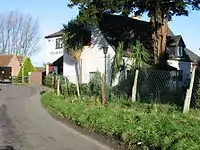Finglesham
Finglesham is a village in the civil parish of Northbourne, and near Deal in Kent, England, which was the location of the Finglesham Anglo-Saxon cemetery, site of a seventh-century Anglo-Saxon archaeology find known as "Finglesham man," as described in 1965 by Sonia Chadwick Hawkes and Hilda Ellis Davidson.[1] The village takes its name from the Old English Pengles-ham, meaning 'prince's manor', with the Anglo-Saxon cemetery containing a number of aristocratic burials.[2] The population of the village is included in the civil parish of Northbourne.
| Finglesham | |
|---|---|
 The Crown public house, Finglesham | |
 Finglesham Location within Kent | |
| OS grid reference | TR3353 |
| District | |
| Shire county | |
| Region | |
| Country | England |
| Sovereign state | United Kingdom |
| Post town | Deal |
| Postcode district | CT14 0 |
| Police | Kent |
| Fire | Kent |
| Ambulance | South East Coast |
It is also known for the presence of a famous road sign (actually at nearby Finglesham Estuary), pointing to the nearby places of both Ham and Sandwich (and thus reading "ham sandwich" as if referring to the common item of food).
The village is also on the Miner's Way Trail. The trail links up the coalfield parishes of East Kent.[3]

 Ham Sandwich finger post
Ham Sandwich finger post
References
- Sonia Chadwick Hawkes, H.R.E Davidson and C. Hawkes. 1965, "The Finglesham Man." Antiquity, 39: 17-32.
- James Campbell. 1991, "The Anglo Saxons" p. 24-5
- "The History of the Coalfield Parishes". www.dover.gov.uk. Archived from the original on 13 January 2014. Retrieved 20 November 2013.
